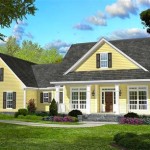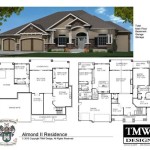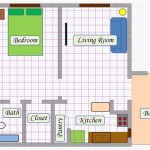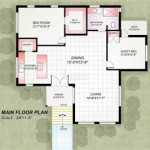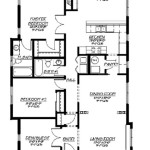```html
6000 Sq Ft Home Plans: Design, Functionality, and Considerations
Designing a home of 6000 square feet requires careful consideration of multiple factors. This size allows for considerable customization and luxury, but it also necessitates meticulous planning to ensure efficient use of space, comfortable living, and adherence to budgetary constraints. A well-executed plan will maximize the potential of the property and create a residence that is both functional and aesthetically pleasing.
The undertaking of building a home of this scale typically involves a team of professionals, including architects, interior designers, structural engineers, and contractors. Each plays a critical role in bringing the homeowner's vision to life while adhering to building codes and best practices. Selecting experienced and reputable professionals is a crucial first step in the process.
Key Point 1: Defining Lifestyle and Spatial Requirements
Before engaging with architectural plans, it’s essential to clearly define the intended lifestyle within the 6000 sq ft home. This involves detailing how each potential room will be utilized and considering the number of occupants. A detailed assessment of needs and wants will inform the architect and designer, ensuring that the final design reflects the homeowner's priorities. For instance, a family that frequently entertains may prioritize a large, open-plan living and dining area, while a family with young children might prioritize a dedicated playroom and expansive backyard.
Specific spatial requirements must also be addressed. This includes the number of bedrooms and bathrooms, the need for home offices, a media room, a gym, or specialized storage spaces. Assessing the need for multi-generational living spaces or accommodations for live-in staff impacts the overall layout and room placements. Detailing these anticipated requirements early in the design phase will prevent costly revisions later in the construction process.
Further considerations include accessibility requirements for individuals with disabilities or mobility challenges. Incorporating wider doorways, ramps, and accessible bathrooms ensures that the home is inclusive and usable for all residents and visitors. These considerations are best integrated into the initial design rather than retrofitted after construction.
The intended aesthetic style also influences spatial requirements. A modern, minimalist design may emphasize open spaces and clean lines, whereas a traditional design may prioritize compartmentalized rooms and ornate detailing. These stylistic choices influence the placement of windows, doors, and interior features, and should be carefully considered and communicated to the design team.
Finally, consider future needs and potential resale value. Designs should be adaptable to accommodate potential changes in lifestyle or family size. Incorporating flexible spaces that can be easily repurposed will increase the long-term usability and marketability of the property.
Key Point 2: Architectural Design and Floor Plan Development
The architect translates the homeowner's spatial requirements and lifestyle preferences into concrete architectural plans. This process begins with conceptual sketches and evolves into detailed floor plans, elevations, and sections. The floor plan is arguably the most crucial element, dictating the flow of movement, room adjacencies, and overall functionality of the house. A well-designed floor plan optimizes space utilization, minimizes wasted areas, and enhances the living experience.
Several common layouts are suitable for a 6000 sq ft home, each with its own advantages and disadvantages. A single-story ranch style allows for easy accessibility and a seamless connection to the outdoors. A two-story design maximizes the use of land and provides a clear separation between living and sleeping areas. A split-level design can be used to accommodate sloped lots and create distinct zones within the home.
The placement of rooms within the floor plan is critical. The master suite is typically located away from the other bedrooms to ensure privacy. High-traffic areas, such as the kitchen and living room, should be centrally located and easily accessible from other parts of the house. Utility areas, such as the laundry room and mudroom, should be strategically placed to minimize disruptions to the main living areas.
The design should also consider the relationship between indoor and outdoor spaces. Large windows, sliding glass doors, and outdoor living areas can create a seamless transition between the interior and exterior, enhancing the overall living experience. Integrating courtyards, patios, and decks into the design can extend the living space and provide opportunities for outdoor recreation and relaxation.
Energy efficiency considerations are paramount in contemporary home design. Solar orientation, window placement, insulation, and HVAC systems all play a role in minimizing energy consumption and reducing utility costs. Incorporating sustainable design principles, such as passive solar heating and cooling, rainwater harvesting, and the use of renewable materials, can further enhance the home's environmental performance.
Furthermore, the architectural style dictates the visual character of the home. Whether it's a modern, traditional, or eclectic design, the architectural style should be consistent throughout the house, from the exterior facade to the interior finishes. The chosen style should complement the surrounding environment and reflect the homeowner's personal taste.
Key Point 3: Interior Design and Material Selection
Interior design focuses on transforming the architectural shell into a comfortable and aesthetically pleasing living space. This involves selecting materials, finishes, fixtures, and furnishings that complement the architectural style and reflect the homeowner's preferences. The interior designer works closely with the architect and homeowner to create a cohesive and harmonious design that meets both functional and aesthetic needs.
Material selection is a critical aspect of interior design. The choice of flooring, wall coverings, countertops, and cabinetry impacts the overall look and feel of the home. Natural materials, such as wood, stone, and leather, can add warmth and texture to the space. Synthetic materials, such as laminate and engineered stone, can offer durability and low maintenance.
Color palettes play a significant role in creating the desired mood and atmosphere. Light colors can make a space feel larger and brighter, while dark colors can create a sense of intimacy and warmth. Neutral colors provide a versatile backdrop for furniture and accessories, while bold colors can add pops of visual interest. The color palette should be consistent throughout the house, creating a sense of continuity and flow.
Lighting design is essential for creating a comfortable and functional living environment. Natural light should be maximized through the strategic placement of windows and skylights. Artificial lighting should be used to supplement natural light and create different moods and effects. A combination of ambient, task, and accent lighting is typically used to achieve the desired illumination levels.
Furniture selection is a key element of interior design. The furniture should be comfortable, functional, and aesthetically pleasing. The size and scale of the furniture should be appropriate for the space. The furniture should be arranged in a way that promotes conversation and relaxation. Consider the flow of traffic and ensure that there is adequate space for movement.
Fixtures and appliances should be selected with both functionality and aesthetics in mind. High-quality appliances and fixtures can enhance the value and enjoyment of the home. Energy-efficient appliances can reduce utility costs and minimize environmental impact. Choose fixtures and appliances that complement the architectural style and interior design.
Finally, consider the integration of technology. Incorporating smart home features, such as automated lighting, climate control, and security systems, can enhance the convenience and security of the home. Pre-wiring for audio-visual systems and data networks ensures that the home is equipped for modern communication and entertainment needs. These advanced technologies can significantly increase comfort and home value.
Beyond these key points, several practical considerations should also inform the plan. Zoning regulations and building codes dictate specific requirements for setbacks, height restrictions, and other aspects of the design. It is essential to comply with all applicable regulations to avoid costly delays and legal issues. A thorough understanding of these regulatory requirements is crucial.
The budget is another significant constraint. A 6000 sq ft home can be expensive to build and maintain. It's crucial to establish a realistic budget early in the process and stick to it as closely as possible. The cost of construction can vary widely depending on the location, materials used, and the complexity of the design. Be prepared for unexpected expenses, and factor a contingency fund into the budget.
The construction timeline is also an important consideration. A home of this size can take several months or even years to complete. It's essential to develop a realistic timeline and monitor progress closely. Delays can be costly and disruptive, so it's important to work with a reliable and experienced contractor.
Landscaping and exterior design are integral to the overall appeal of the property. The landscaping should complement the architectural style of the home and create a welcoming and inviting atmosphere. Consider the placement of trees, shrubs, and flowers, and ensure that the landscaping is easy to maintain. Outdoor lighting can enhance the beauty of the property at night and provide added security.
Ongoing maintenance is a factor that should not be overlooked. A 6000 sq ft home requires significant upkeep. Consider the cost of cleaning, landscaping, and repairs when planning the design. Choose low-maintenance materials and finishes to minimize long-term costs. A proactive maintenance plan can help prevent costly repairs and extend the lifespan of the home.
Ultimately, a successful 6000 sq ft home plan is one that reflects the homeowner's lifestyle, meets their spatial requirements, and adheres to budgetary constraints. By carefully considering these factors and working with experienced professionals, it's possible to create a residence that is both functional and aesthetically pleasing, providing a comfortable and enjoyable living environment for many years to come. The journey of designing and building a custom home is often complex but the rewards of living in a thoughtfully designed space are substantial.
```
Transitional Home Plan Under 6000 Square Feet With Two Offices Upstairs 490087nah Architectural Designs House Plans

European Style House Plan 5 Beds 7 Baths 6000 Sq Ft 72 197 Plans Floor Design How To

House Plan 65651 Southern Style With 6000 Sq Ft 5 Bed 6 Bath

House Hautbois Ii Plan Green Builder Plans

How To Squeeze 6 000 Square Feet Into A 4 Foot Home Cornerstone Custom Construction Builder Lake Mary Fl

European Style House Plan 5 Beds 7 Baths 6000 Sq Ft 45 181 Houseplans Com

6000 Square Feet House Ground Floor Plan With Furniture Layout Dwg File Cadbull

Rustic Lake Style House Plan 3131 Sheridan Ii Luxury Plans European

Featured House Plan Bhg 6774

U10612r House Plans Over 700 Proven Home Designs By Korel


